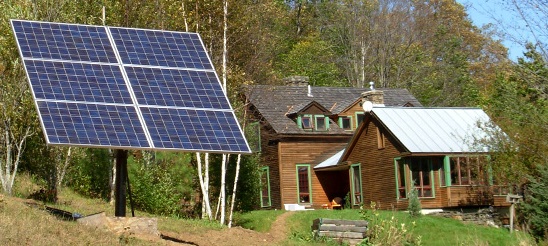
This off-grid Solar system is completely cut off from the traditional grid. It best suits locations such as cabins in the woods, mountains or remote areas of the developing world with no electric grid.
This system also incorporates the battery and the power generator in its design. Instead of using a battery or generator as a simple back-up, it is used as a necessary component. The battery is used to save electricity for rainy days – literally – while a generator is needed when the battery drains out due to continues use and in days with no power production.
Schneider Electric explains what to Look for in an Off-grid Solar Inverter:
The modern solar industry was born through off-grid solar, a market which continues to be an important aspect of the industry. Around the world, one in six people live beyond the reach of utility power, but they can rely on off-grid solar systems for electricity. In North America, off-grid solar is especially popular for buildings in remote locations where the utility grid does not yet reach, or in places prone to storms and power outages.
Off-grid solar installations are less common than grid-tie systems for a number of reasons. An off-grid system requires more components like batteries and charge controllers. With additional components, the installation is more complex and requires a higher level of technical training. It is also more costly for the end user, and not all end users need off-grid solar.
Although off-grid is more complex than grid-tie, the off-grid market continues to grow and there is a shift with experienced installers beginning to move from the competitive grid-tie market to the more lucrative off-grid market. Solar product suppliers are also working to make off-grid installations easier. Look for the following offers:
Off-Grid Packages
Off-grid system integrators can lessen the complexity of an off-grid system by providing easy-to-install packages. A package can include an inverter/charger, solar charge controllers, control panels and accessories. The components should all work together upon taking them out of the box. Ordering an off-grid system as a package also ensures all the necessary parts are together and eliminating the need to contact the supplier from a job site to rush a forgotten part.
Flexible Off-Grid Inverters
Another way to cut down on the complexity of off-grid solar projects is to find an inverter/charger that is flexible enough to meet any installation requirement. Look for inverters with intelligent load management to handle a diverse set of energy loads. Load management becomes incredibly important when connecting your inverter to a generator, or to the utility grid. Some inverters have dual AC inputs to accommodate both the generator and the grid, which lowers the additional system component requirements and allows more flexibility in covering differing system needs. Connecting an off-grid solar system to the utility grid (where possible) also gives the end user the opportunity to sell back excess energy to their utility company.
Stackable Off-Grid Inverters
Building an off-grid solar system requires a sizeable up-front investment. It is common for homeowners to start with a smaller-size system, with plans to add on at a later date. Adding more solar is easy when starting with an inverter that can be stacked together with other inverters. It is also becoming more common to attach an off-grid solar inverter to an existing grid-tie solar system through AC coupling. A grid-tie solar system is great, but it requires utility power to operate and shuts off during any utility power outages. Only off-grid inverters paired with batteries will provide uninterrupted power for critical loads.
Customer Service
As mentioned earlier, off-grid solar systems are useful for buildings in remote locations. However, remote locations require extra travel time to reach. To cut back on site visits, choose inverters that have proven reliability and will last for years. Trust suppliers that have been financially successful in the off-grid market for many years. Ask them to provide references for older installations, or show you how the product is internally tested.
If service is necessary, it’s important the supplier be available to troubleshoot and provide quick resolution. The supplier should also be accessible by the end user for emergencies. New technology makes troubleshooting quicker by allowing remote connections to the off-grid inverter. This can be done through a remote monitoring system. Look for systems that can also upgrade firmware remotely.
As the off-grid solar market continues to grow, these offerings will ensure that off-grid off-grid solar installations are safe, reliable, and cost effective.

; ?>wp-content/themes/srptheme/images/Studion.png)